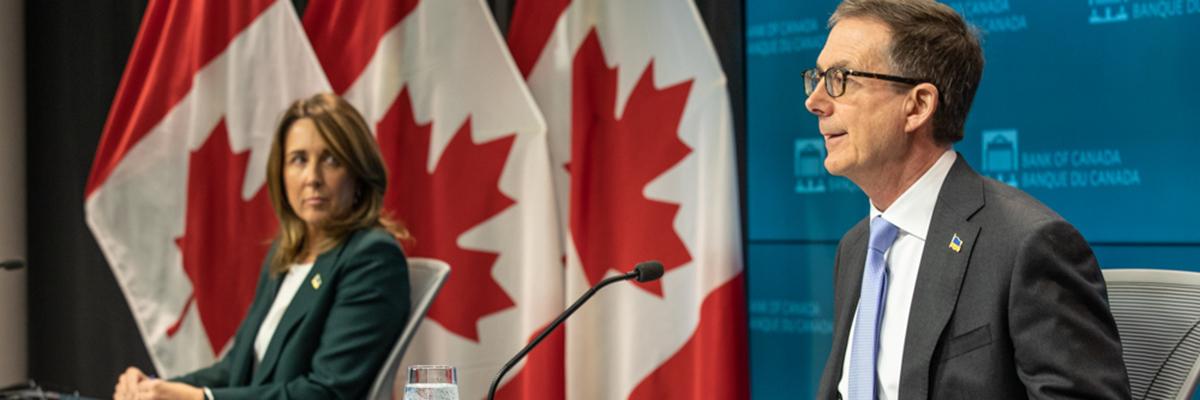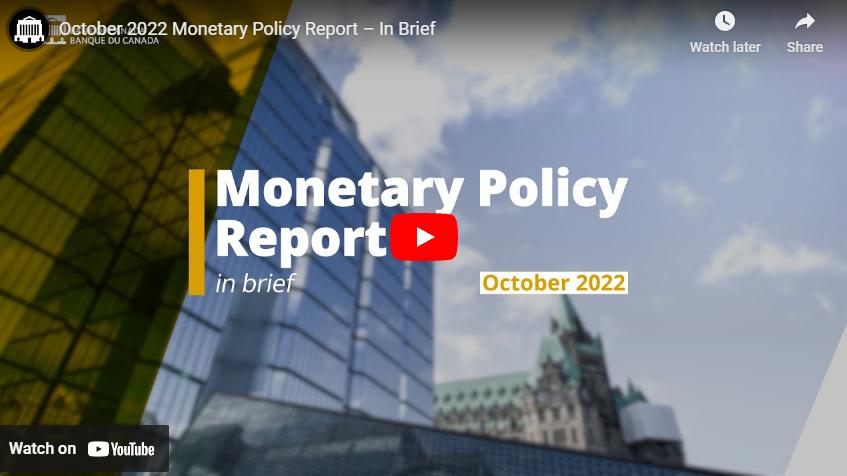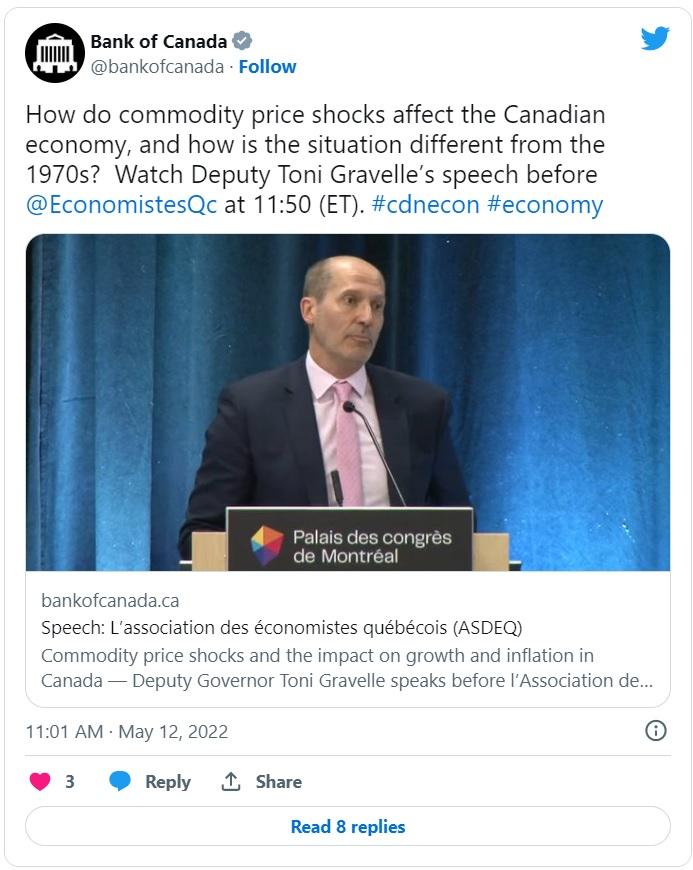
Monetary policy
Growth was robust in the first half of 2022 as the Canadian economy reopened. High commodity prices and the easing of public health restrictions boosted economic activity.
At the same time, a tight labour market and global supply chain challenges restrained the ability of supply to meet strong demand from households and businesses. High global energy and food prices, in addition to excess demand, contributed to a rise in inflation that peaked in June at 8.1%.
In this context, the Bank of Canada raised its policy rate seven times in 2022, for a total increase of 400 basis points. It also undertook quantitative tightening. By year-end, the Canadian economy had slowed significantly, and inflation had fallen to 6.3%.
Consumer price index inflation reaching a 40-year high
Throughout 2022, the rise in inflation in Canada and abroad was pronounced. This was partly due to global developments—the war in Ukraine, strong global demand for traded goods and continued supply chain disruptions boosted inflation around the world. But what started as inflation driven by higher global energy and goods prices became generalized inflation as domestic prices also began moving up quickly. As the Canadian economy reopened, not enough goods and services were available to meet strong demand, and businesses raised prices.
In the second half of the year, inflation started to decline, mostly due to falling gasoline prices, but by year-end it was still well above the Bank’s target.
Near-term inflation expectations in Canada rose through 2022, as they did in many other economies. The Bank’s survey results indicated that consumers and businesses became more uncertain about future inflation and more of them expected it to be higher for longer.1 However, longer-term inflation expectations remained reasonably well anchored.
Taking action on high inflation
The COVID-19 pandemic has had serious implications for the economy and the financial system. The Bank, like many of its central bank peers, took extraordinary action to restore the functioning of financial markets, mitigate severe economic fallout and support the economic recovery.
Most recently, central banks have been increasing policy rates to address high inflation. The Bank began to raise its policy rate in March 2022 and was among the most forceful in using higher interest rates to cool inflation. The Bank was also among the first to begin quantitative tightening, which it did in April by ceasing to replace its maturing bond investments. Quantitative tightening complements the rise in the policy interest rate by putting upward pressure on long-term interest rates and making borrowing more expensive.
To reinforce the target rate, the Bank modified the structure and terms of its financial market operations. The Bank also announced that it will continue to implement monetary policy through a floor system—as opposed to a corridor system—where the interest rate on the overnight deposit facility is equal to the target for the overnight rate.2
With the increases in the policy interest rate, the Bank, like many other central banks that used their balance sheet to help lower interest rates, is now facing net losses—$1.11 billion in 2022. The losses are occurring because the interest the Bank receives on the assets it bought remains fixed, but the interest it pays on settlement balances used to finance the asset purchases has increased along with the policy rate.
The size and duration of these losses will depend on the path of interest rates and the evolution of both the economy and the balance sheet. The losses have no impact on monetary policy or the Bank’s operations. Policy decisions are guided by the Bank’s price and financial stability mandates.
Slower growth and easing inflation pressures in the second half of 2022
Tighter monetary policy helped start to rebalance supply and demand in the economy. In the second half of the year, economic activity started showing signs of moderation, including softening demand in sectors sensitive to interest rates.
- The housing market was the first sector to slow in response to tighter financial conditions.
- Increases in interest rates also dampened consumption growth.
Overall, economic growth was at 0.0% by the fourth quarter.
In addition to signs that demand was slowing, supply was also improving.
- While supply chain bottlenecks remained an issue throughout 2022, trade data and business survey results suggest improvement in the second half of the year.
- Labour markets remained tight, but labour shortages faced by businesses eased slightly toward the end of the year.3
In this context, three-month rates of total consumer price index (CPI) inflation and core inflation receded, indicating that CPI inflation would likely continue to moderate in the coming months.
We are seeing early signs that balance between supply and demand has started to be restored. Read Deputy Governor Sharon Kozicki’s speech before @iduquebec to learn more: http://ow.ly/OePi50LYL6b #cdnecon Dec 8, 2022
Supporting the Bank’s monetary policy function
Despite the highly complex forces affecting total supply and demand, the Bank correctly anticipated that growth in gross domestic product in Canada and abroad would be robust in the first half of 2022 before moderating in the second half of the year. However, the extent of the continued rise in inflation was much greater than expected.
| Achievement of target for consumer price index (CPI) inflation | |||||||
| Key indicators | Reference level | 2017 | 2018 | 2019 | 2020 | 2021 | 2022 |
| CPI inflation (%) | 2.0 | 1.6 | 2.3 | 1.9 | 0.7 | 3.4 | 6.8 |
| Average CPI inflation since 2001 (%) | 2.1 | ||||||
| Inflation expectations at a 10-year horizon (%) | 2.0 | 2.0 | 2.0 | 2.0 | 2.0 | 2.0 | 2.0 |
Working to better understand inflationary pressures and expectations
The appendix to the July 2022 Monetary Policy Report describes why the Bank missed predicting the rise in inflation and its persistence:
- Global factors appear to explain about two-thirds of the inflation miss. In particular, commodity prices were unexpectedly high following the Russian invasion of Ukraine. Increased supply shortages and rising shipping costs also contributed to stronger inflation.
- The faster-than-expected recovery in the Canadian economy added to the Bank’s inflation forecast errors.
Staff conducted extensive analysis on inflation expectations:
- The Bank’s consumer and business surveys provided key information on the evolution of Canadians’ expectations.
- Staff considered different paths for how expectations might evolve and assessed the implications for the inflation forecast.
This work also allowed the Bank to analyze various macroeconomic scenarios in which long-term inflation expectations become de-anchored as well as their implications for monetary policy.
How do commodity price shocks affect the Canadian economy, and how is the situation different from the 1970s? Watch Deputy Toni Gravelle’s speech before @EconomistesQc at 11:50 (ET). #cdnecon #economy https://t.co/KunhnODmyC
— Bank of Canada (@bankofcanada) May 12, 2022
Integrating a variety of data points to strengthen analysis
Reflecting the high level of economic uncertainty, the Bank sought out new data to augment its analysis.
- It developed a new survey, the Business Leaders’ Pulse, which allows the Bank to reach a more diverse set of firms than before.
- The Market Participants Survey collects information from market participants on their expectations about key macroeconomic variables and monetary policy. This survey feeds into the Bank’s financial market analysis and supports policy decisions.
- Innovative use of disaggregated data helps to deepen the Bank’s understanding of several issues—for instance, the uneven effects of monetary policy on households and on businesses.
The Bank continued to integrate climate considerations into its assessment of the economy. This included reviewing macroeconomic modelling of approaches to the transition to low carbon and beginning to modify the Bank’s large-scale models to better capture the economic impacts of the transition to net-zero emissions.
The Bank is committed to advancing economic inclusion and opportunity for Indigenous Peoples. In 2022, it began to lay the groundwork with Indigenous groups across Canada to develop an economic reconciliation action plan.4 Bank staff also examined how monetary policy is transmitted to Indigenous economies. Such analysis gives the Bank a clearer picture of the different ways its actions affect various groups.
Looking forward
In 2023, the Bank will continue to assess the effects of higher interest rates on inflation and the broader economy. In addition, the Bank will:
- continue to identify and quantify the factors that drive inflation, including the roles of domestic supply and global factors
- improve its macroeconomic models to help shed light on inflation pressures, including through richer modelling of production networks, input-output linkages and wage- and price-setting behaviours
- extend work on what digitalization, automation and the adoption of advanced technologies mean for the Canadian economy
- initiate a review to determine the appropriate steady-state level of settlement balances and support the implementation of monetary policy and long-term management of the Bank’s balance sheet
- enhance its surveys of businesses and consumers to better understand the changing economy and begin publishing the results of its Market Participants Survey roughly two weeks after the publication of each Monetary Policy Report, starting in February 2023
- 1. Bank of Canada, Canadian Survey of Consumer Expectations and Business Outlook Survey.[←]
- 2. Bank of Canada, “Bank of Canada announces changes to its operations to reinforce its target for the overnight rate” (market notice, March 2, 2022).[←]
- 3. Bank of Canada, “Labour market recovery from COVID‑19.”[←]
- 4. L. Schembri, “Economic reconciliation: Supporting a return to Indigenous prosperity” (speech to the National Aboriginal Capital Corporations Association, Gatineau, Quebec, May 5, 2022).[←]


